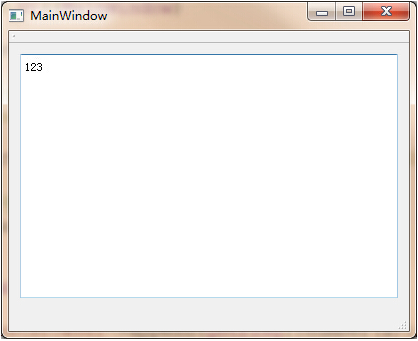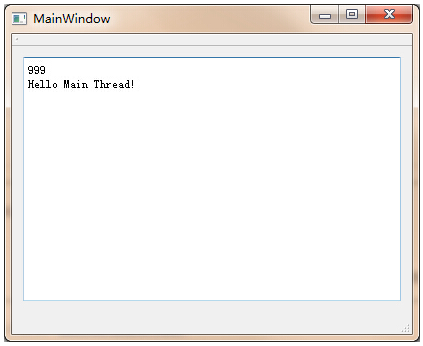Qt多執行緒通訊
簡述:
1> Qt執行緒間共享資料主要有兩種方式:
第一種方法在各個程式語言都普遍使用,而第二種方法是QT的特有的,本文主要介紹第二種。1)使用共享記憶體。即使用一個兩個執行緒都能夠共享的變數(如全域性變數),這樣兩個執行緒都能夠訪問和修改該變數,從而達到共享資料的目的。
2)使用singal/slot機制,把資料從一個執行緒傳遞到另外一個執行緒。
2 > 槽引數型別
1) 線上程間使用訊號槽進行通訊時,槽引數必須使用元資料型別的引數;
2) Qt內生的元資料型別,如int double QString等;
3) 如果要用自定義的資料型別,需要在connect之前
將其註冊(qRegisterMetaType)為元資料型別。4) 執行緒間用“訊號與槽”傳遞引用引數的話,要加const,因為const文字常量存在常量區中,生命週期與程式一樣的長。這樣可以避免slot呼叫的時候引數的執行期已過而使引用無效。
connect(m_thread, SIGNAL(MsgSignal(const QString&)),
this, SLOT(OnMsgSignal(const QString&)));
3 > Q_DECLARE_METATYPE與qRegisterMetaType
Q_DECLARE_METATYPE
如果要使自定義型別或其他非QMetaType內建型別在QVaiant中使用,必須使用該巨集。
該型別必須有公有的 構造、析構、複製建構函式。
qRegisterMetaType
必須使用該函式的兩種情況:
如果非QMetaType內建型別要在Qt的屬性系統中使用。
如果非QMetaType內建型別要在queued 訊號與槽中使用。
兩者的關係:
Q_DECLARE_METATYPE展開後是一個特化後的類QMetaTypeId<TYPE>
qRegisterMetaType將某型別註冊到MetaType系統中。
QMetaTypeId<TYPE>的類中成員包含對qRegisterMetaType的呼叫。
1、傳遞int引數(主執行緒與子執行緒)
testthread.h 檔案
#ifndef TESTTHREAD_H #define TESTTHREAD_H #include <QThread> #include "msg.h" class TestThread : public QThread { Q_OBJECT public: explicit TestThread(QObject *parent = 0); protected: void run(); signals: void TestSignal(int); private: Msg msg; }; #endif // TESTTHREAD_Htestthread.cpp檔案
#include "testthread.h" TestThread::TestThread(QObject *parent) : QThread(parent) { } void TestThread::run() { //觸發訊號 emit TestSignal(123); }
自定義的類繼承了QThread類,重寫run函式,然後觸發TestSignal訊號。
mainwindow.h
#ifndef MAINWINDOW_H #define MAINWINDOW_H #include <QMainWindow> #include "testthread.h" namespace Ui { class MainWindow; } class MainWindow : public QMainWindow { Q_OBJECT public: explicit MainWindow(QWidget *parent = 0); ~MainWindow(); private slots: void DisplayMsg(int); private: Ui::MainWindow *ui; TestThread *t; }; #endif // MAINWINDOW_Hmainwindow.cpp
#include "mainwindow.h" #include "ui_mainwindow.h" MainWindow::MainWindow(QWidget *parent) : QMainWindow(parent), ui(new Ui::MainWindow) { ui->setupUi(this); //進行connect前必須例項化 t = new TestThread(); connect(t, SIGNAL(TestSignal(int)), this, SLOT(DisplayMsg(int))); //執行子執行緒 t->start(); } void MainWindow::DisplayMsg(int a) { ui->textBrowser->append(QString::number(a)); } MainWindow::~MainWindow() { delete ui; }
Mainwindow裡面連線訊號槽,並且將收到的int引數顯示在介面上。
執行效果:
2、傳遞自定義引數(主執行緒與子執行緒)
對以上程式進行簡單的修改,使它傳遞自定義訊息。
testthread.h 檔案
#ifndef TESTTHREAD_H #define TESTTHREAD_H #include <QThread> #include "msg.h" class TestThread : public QThread { Q_OBJECT public: explicit TestThread(QObject *parent = 0); Msg msg; protected: void run(); signals: void TestSignal(Msg); //自定義訊息Msg!!! }; #endif // TESTTHREAD_H
testthread.cpp檔案#include "testthread.h" TestThread::TestThread(QObject *parent) : QThread(parent) { } void TestThread::run() { msg.int_info = 999; msg.str_info = "Hello Main Thread!"; //觸發訊號 emit TestSignal(msg); }
mainwindow.h#ifndef MAINWINDOW_H #define MAINWINDOW_H #include <QMainWindow> #include "testthread.h" #include "msg.h" namespace Ui { class MainWindow; } class MainWindow : public QMainWindow { Q_OBJECT public: explicit MainWindow(QWidget *parent = 0); ~MainWindow(); private slots: void DisplayMsg(Msg); //Msg!!! private: Ui::MainWindow *ui; TestThread *t; }; #endif // MAINWINDOW_Hmainwindow.cpp
#include "mainwindow.h" #include "ui_mainwindow.h" MainWindow::MainWindow(QWidget *parent) : QMainWindow(parent), ui(new Ui::MainWindow) { ui->setupUi(this); //進行connect前必須例項化 t = new TestThread(); //Msg!!! connect(t, SIGNAL(TestSignal(Msg)), this, SLOT(DisplayMsg(Msg))); //執行子執行緒 t->start(); } void MainWindow::DisplayMsg(Msg msg) { ui->textBrowser->append(QString::number(msg.int_info)); ui->textBrowser->append(msg.str_info); } MainWindow::~MainWindow() { delete ui; }
此時再進行編譯,編譯通過,但Qt Creator會有提示:
QObject::connect: Cannot queue arguments of type 'Msg' (Make sure 'Msg' is registered using qRegisterMetaType().)
並且執行程式時會發現,訊號傳送了,槽函式始終不呼叫。
如果將槽引數註冊為元資料型別,即mainwindow.cpp檔案改動一下:
ui->setupUi(this); qRegisterMetaType<Msg>("Msg");
此時便可正常執行:
3、傳遞自定義引數(子執行緒與子執行緒)
原理同上,然後把connect函式中的第三引數this(主執行緒)改成要監聽的另一個執行緒物件就好了(QT多麼健壯、友好、強大)。
connect(t, SIGNAL(TestSignal(Msg)), this, SLOT(DisplayMsg(Msg)));
前提是全部的執行緒都要在主執行緒裡面例項化(new)。
4、傳遞自定義結構體引數(子執行緒與子執行緒)
實現子執行緒與GUI子執行緒的引數進行傳遞。
執行緒
標頭檔案 ABFThread.h
public: struct G_ABFTableSrcUnit { int a; int b; int c; float d; float e; unsigned int f; float Gg; QString waveformTypel; }; public slots: void parameterPassing(abfThread::G_ABFTableSrcUnit); //執行緒自己呼叫自己的結構體。。。必須這麼寫不然主執行緒會報錯的 錯誤是引數內容不一樣
ABFThread.cpp
void abfThread::parameterPassing(abfThread::G_ABFTableSrcUnit) { }
GUI執行緒radarControl.h
radarControl.cpp#include "abfThread" private: Ui::radarControl *ui; abfThread::G_ABFTableSrcUnit mst_abfSrcUnit; signals: void sendString(abfThread::G_ABFTableSrcUnit);
按下按鈕就發射訊號mainwindow.hvoid radarControl::on_pushButton_clicked() { emit sendString(mst_abfSrcUnit); }mainwindow.cpp#include "abfThread.h" #include "radarControl.h"radarInterface = new radarControl(); m_ABFThread = new QThread(); m_ABF = new abfThread(); m_ABF->moveToThread(m_ABFThread); m_ABFThread->start(); qRegisterMetaType<abfThread::G_ABFTableSrcUnit>("abfThread::G_ABFTableSrcUnit"); connect(radarInterface,SIGNAL(sendString(abfThread::G_ABFTableSrcUnit)),m_ABF,SLOT(parameterPassing(abfThread::G_ABFTableSrcUnit))); //除了註冊結構體外 還要保證傳遞的引數寫法要一樣 這就是為什麼 前面執行緒自己定義的結構體自己呼叫自己的原因了
小結:
1 > Qt的訊號槽函式只預設支援Qt的型別和C++提供的內建的基本型別,比如int double float等,根本不支援C++的std::string std::vector 自定義的struct型別。所以需要用Qt提供的Q_DECLARE_METATYPE和qRegisterMetaType來宣告和註冊自定義的型別和C++的其他型別。
2 > 多執行緒間的訊號槽傳遞,在connect的時候需要以Qt::QueuedConnection的方式,不然以Qt::DirectConnection的方式接收者UI執行緒會很長時間收不到後臺執行緒發出的訊號,或者訊號直接丟失都是有可能的


